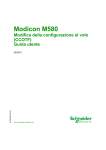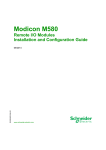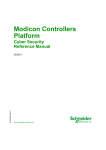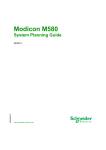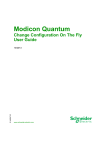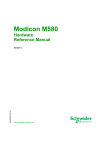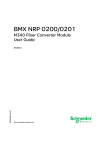Download User Manual - Schneider
Transcript
Modicon M580 EIO0000001590 10/2014 Modicon M580 Change Configuration On The Fly User Guide EIO0000001590.01 10/2014 www.schneider-electric.com The information provided in this documentation contains general descriptions and/or technical characteristics of the performance of the products contained herein. This documentation is not intended as a substitute for and is not to be used for determining suitability or reliability of these products for specific user applications. It is the duty of any such user or integrator to perform the appropriate and complete risk analysis, evaluation and testing of the products with respect to the relevant specific application or use thereof. Neither Schneider Electric nor any of its affiliates or subsidiaries shall be responsible or liable for misuse of the information contained herein. If you have any suggestions for improvements or amendments or have found errors in this publication, please notify us. No part of this document may be reproduced in any form or by any means, electronic or mechanical, including photocopying, without express written permission of Schneider Electric. All pertinent state, regional, and local safety regulations must be observed when installing and using this product. For reasons of safety and to help ensure compliance with documented system data, only the manufacturer should perform repairs to components. When devices are used for applications with technical safety requirements, the relevant instructions must be followed. Failure to use Schneider Electric software or approved software with our hardware products may result in injury, harm, or improper operating results. Failure to observe this information can result in injury or equipment damage. © 2014 Schneider Electric. All rights reserved. 2 EIO0000001590 10/2014 Table of Contents Safety Information . . . . . . . . . . . . . . . . . . . . . . . . . . . . . About the Book. . . . . . . . . . . . . . . . . . . . . . . . . . . . . . . . Part I Introduction to Modicon M580 Change Configuration On The Fly . . . . . . . . . . . . . . . . . . . Chapter 1 Modicon M580 CCOTF Presentation. . . . . . . . . . . . . . . What is CCOTF? . . . . . . . . . . . . . . . . . . . . . . . . . . . . . . . . . . . . . . . . . General Advise for Using CCOTF . . . . . . . . . . . . . . . . . . . . . . . . . . . . Allowed CCOTF Modifications in Modicon M580 . . . . . . . . . . . . . . . . Which Parameters Can be Changed with CCOTF? . . . . . . . . . . . . . . CCOTF Counting and Status. . . . . . . . . . . . . . . . . . . . . . . . . . . . . . . . Chapter 2 CCOTF Prerequisites . . . . . . . . . . . . . . . . . . . . . . . . . . . Modicon M580 Hardware Compatibility with CCOTF . . . . . . . . . . . . . Modicon M580 Settings for CCOTF . . . . . . . . . . . . . . . . . . . . . . . . . . Part II How to Perform a CCOTF Modification . . . . . . . . Chapter 3 Adding a Remote I/O Drop. . . . . . . . . . . . . . . . . . . . . . . Adding a Remote I/O Drop Using the Standard Connected Mode . . . Adding a Remote I/O Drop Using the Virtual Connected Mode . . . . . Chapter 4 Adding/Deleting Modules . . . . . . . . . . . . . . . . . . . . . . . Adding/Deleting a Module Using the Standard Connected Mode . . . . Adding/Deleting a Module Using the Virtual Connected Mode . . . . . . Chapter 5 Modifying Module Parameters . . . . . . . . . . . . . . . . . . . Modifying Module Parameters Using the Standard Connected Mode. Modifying Module Parameters Using the Virtual Connected Mode . . . Glossary EIO0000001590 10/2014 ......................................... 5 9 13 15 16 17 19 21 23 25 26 27 29 31 32 34 37 38 41 43 44 45 47 3 4 EIO0000001590 10/2014 Safety Information Important Information NOTICE Read these instructions carefully, and look at the equipment to become familiar with the device before trying to install, operate, or maintain it. The following special messages may appear throughout this documentation or on the equipment to warn of potential hazards or to call attention to information that clarifies or simplifies a procedure. EIO0000001590 10/2014 5 PLEASE NOTE Electrical equipment should be installed, operated, serviced, and maintained only by qualified personnel. No responsibility is assumed by Schneider Electric for any consequences arising out of the use of this material. A qualified person is one who has skills and knowledge related to the construction and operation of electrical equipment and its installation, and has received safety training to recognize and avoid the hazards involved. BEFORE YOU BEGIN Do not use this product on machinery lacking effective point-of-operation guarding. Lack of effective point-of-operation guarding on a machine can result in serious injury to the operator of that machine. WARNING UNGUARDED EQUIPMENT Do not use this software and related automation equipment on equipment which does not have point-of-operation protection. Do not reach into machinery during operation. Failure to follow these instructions can result in death, serious injury, or equipment damage. This automation equipment and related software is used to control a variety of industrial processes. The type or model of automation equipment suitable for each application will vary depending on factors such as the control function required, degree of protection required, production methods, unusual conditions, government regulations, etc. In some applications, more than one processor may be required, as when backup redundancy is needed. Only you, the user, machine builder or system integrator can be aware of all the conditions and factors present during setup, operation, and maintenance of the machine and, therefore, can determine the automation equipment and the related safeties and interlocks which can be properly used. When selecting automation and control equipment and related software for a particular application, you should refer to the applicable local and national standards and regulations. The National Safety Council’s Accident Prevention Manual (nationally recognized in the United States of America) also provides much useful information. In some applications, such as packaging machinery, additional operator protection such as pointof-operation guarding must be provided. This is necessary if the operator’s hands and other parts of the body are free to enter the pinch points or other hazardous areas and serious injury can occur. Software products alone cannot protect an operator from injury. For this reason the software cannot be substituted for or take the place of point-of-operation protection. 6 EIO0000001590 10/2014 Ensure that appropriate safeties and mechanical/electrical interlocks related to point-of-operation protection have been installed and are operational before placing the equipment into service. All interlocks and safeties related to point-of-operation protection must be coordinated with the related automation equipment and software programming. NOTE: Coordination of safeties and mechanical/electrical interlocks for point-of-operation protection is outside the scope of the Function Block Library, System User Guide, or other implementation referenced in this documentation. START-UP AND TEST Before using electrical control and automation equipment for regular operation after installation, the system should be given a start-up test by qualified personnel to verify correct operation of the equipment. It is important that arrangements for such a check be made and that enough time is allowed to perform complete and satisfactory testing. CAUTION EQUIPMENT OPERATION HAZARD Verify that all installation and set up procedures have been completed. Before operational tests are performed, remove all blocks or other temporary holding means used for shipment from all component devices. Remove tools, meters, and debris from equipment. Failure to follow these instructions can result in injury or equipment damage. Follow all start-up tests recommended in the equipment documentation. Store all equipment documentation for future references. Software testing must be done in both simulated and real environments. Verify that the completed system is free from all short circuits and temporary grounds that are not installed according to local regulations (according to the National Electrical Code in the U.S.A, for instance). If high-potential voltage testing is necessary, follow recommendations in equipment documentation to prevent accidental equipment damage. Before energizing equipment: Remove tools, meters, and debris from equipment. Close the equipment enclosure door. Remove all temporary grounds from incoming power lines. Perform all start-up tests recommended by the manufacturer. EIO0000001590 10/2014 7 OPERATION AND ADJUSTMENTS The following precautions are from the NEMA Standards Publication ICS 7.1-1995 (English version prevails): Regardless of the care exercised in the design and manufacture of equipment or in the selection and ratings of components, there are hazards that can be encountered if such equipment is improperly operated. It is sometimes possible to misadjust the equipment and thus produce unsatisfactory or unsafe operation. Always use the manufacturer’s instructions as a guide for functional adjustments. Personnel who have access to these adjustments should be familiar with the equipment manufacturer’s instructions and the machinery used with the electrical equipment. Only those operational adjustments actually required by the operator should be accessible to the operator. Access to other controls should be restricted to prevent unauthorized changes in operating characteristics. 8 EIO0000001590 10/2014 About the Book At a Glance Document Scope This guide provides information about the Change Configuration On The Fly (CCOTF) feature in a M580 system, using Unity Pro software. NOTE: The specific configuration settings contained in this guide are intended to be used for instructional purposes only. The settings required for your specific configuration may differ from the examples presented in this guide. Validity Note This document is valid for the M580 system when used with Unity Pro 8.1 or later. The technical characteristics of the devices described in this document also appear online. To access this information online: Step Action 1 Go to the Schneider Electric home page www.schneider-electric.com. 2 In the Search box type the reference of a product or the name of a product range. Do not include blank spaces in the model number/product range. To get information on grouping similar modules, use asterisks (*). 3 If you entered a reference, go to the Product Datasheets search results and click on the reference that interests you. If you entered the name of a product range, go to the Product Ranges search results and click on the product range that interests you. 4 If more than one reference appears in the Products search results, click on the reference that interests you. 5 Depending on the size of your screen, you may need to scroll down to see the data sheet. 6 To save or print a data sheet as a .pdf file, click Download XXX product datasheet. The characteristics that are presented in this manual should be the same as those characteristics that appear online. In line with our policy of constant improvement, we may revise content over time to improve clarity and accuracy. If you see a difference between the manual and online information, use the online information as your reference. EIO0000001590 10/2014 9 Related Documents 10 Title of Documentation Reference Number Modicon M580 BME NOC 03•1 Ethernet Module Installation and Configuration Guide HRB62665 (English), HRB65311 (French), HRB65313 (German), HRB65314 (Italian), HRB65315 (Spanish), HRB65316 (Chinese) Modicon M580 Remote I/O Modules Installation and Configuration Guide EIO0000001584 (English), EIO0000001585 (French), EIO00000 01586 (German), EIO0000001588 (It alian), EIO0000001587 (Spanish), EIO0000001589 (Chinese) Modicon M580 Hardware Reference Manual EIO0000001578 (English), EIO0000001579 (French), EIO0000001580 (German), EIO0000001582 (Italian), EIO0000001581 (Spanish), EIO0000001583 (Chinese) Modicon M580 System Planning Guide HRB62666 (English), HRB65318 (French), HRB65319 (German), HRB65320 (Italian), HRB65321 (Spanish), HRB65322 (Chinese) Modicon M340/X80 BMX NRP 0200/0201 Fiber Converter Module User Guide EIO0000001108 (English), EIO0000001110 (German), EIO0000001109 (French), EIO0000001111 (Spanish), EIO0000001112 (Italian), EIO0000001113 (Chinese) Modicon X80 with Unity Pro HART Analog Input/Output Modules User Manual EAV16400 (English), EAV28404 (French), EAV28384 (German), EAV28360 (Spanish), EAV28413 (Italian), EAV28417 (Chinese) EIO0000001590 10/2014 Title of Documentation Reference Number Modicon M340/ X80 with Unity Pro Analog Input/Output Modules User Manual 35011978 (English), 35011980 (French), 35011979 (German), 35011981 (Spanish), 35011982 (Italian), 35011983 (Chinese) Modicon M340/ X80 with Unity Pro Discrete Input/Output Modules User Manual 35012474 (English), 35012476 (French), 35012475 (German), 35012477 (Spanish), 35012478 (Italian), 35012479 (Chinese) Modicon M340/ X80 with Unity Pro BMX EHC 0200 Counting Modules User Manual 35013355 (English), 35013357 (French), 35013356 (German), 35013358 (Spanish), 35013359 (Italian), 35013360 (Chinese) Unity Pro Operating Modes 33003101 (English), 33003102 (French), 33003103 (German), 33003104 (Spanish), 33003696 (Italian), 33003697 (Chinese) Unity Pro Installation Manual 35014793 (English), 35014792 (French), 35014794 (German), 35014795 (Spanish), 35014796 (Italian), 35012191 (Chinese) Unity Pro Program Languages and Structure Reference Manual 35006144 (English), 35006145 (French), 35006146 (German), 35006147 (Spanish), 35013361 (Italian), 35013362 (Chinese) You can download these technical publications and other technical information from our website at www.schneider-electric.com. EIO0000001590 10/2014 11 12 EIO0000001590 10/2014 Modicon M580 Introduction EIO0000001590 10/2014 Part I Introduction to Modicon M580 Change Configuration On The Fly Introduction to Modicon M580 Change Configuration On The Fly Overview This part describes the CCOTF feature for Modicon M580 in conjunction with Unity Pro. What Is in This Part? This part contains the following chapters: Chapter Chapter Name Page 1 Modicon M580 CCOTF Presentation 15 2 CCOTF Prerequisites 25 EIO0000001590 10/2014 13 Introduction 14 EIO0000001590 10/2014 Modicon M580 Modicon M580 CCOTF Presentation EIO0000001590 10/2014 Chapter 1 Modicon M580 CCOTF Presentation Modicon M580 CCOTF Presentation Overview This chapter details the CCOTF capabilities and how the CPU executes a CCOTF request. What Is in This Chapter? This chapter contains the following topics: Topic Page What is CCOTF? 16 General Advise for Using CCOTF 17 Allowed CCOTF Modifications in Modicon M580 19 Which Parameters Can be Changed with CCOTF? 21 CCOTF Counting and Status 23 EIO0000001590 10/2014 15 Modicon M580 CCOTF Presentation What is CCOTF? Definitions Change Configuration On the Fly (CCOTF) is a feature that allows you to modify the PAC hardware configuration and parameters using Unity Pro while the PAC is running normally without impacting the tasks being performed in the other modules. When a CCOTF modification is executed on a drop, for example Adding / Deleting a module, there is no effect on any other drop in the configuration. A CCOTF transaction is a set of CCOTF modifications built together in Unity Pro. In Unity Pro, a CCOTF modification is referred to as a Configuration Online modification in RUN mode and is part of the Online changes; the other changes are performed using Tools →PLC Screen and include cold start, warm start, etc. (Refer to Overview of the CPU debugging screen.) CCOTF can use both standard and virtual connected modes; refer to the descriptions. Types of CCOTF Modifications There are several types of CCOTF modifications whether they affect the whole local rack (or the drop), a module or a parameter. All the CCOTF modifications in one transaction must be of the same type. A drop transaction must affect one drop. All the module additions / deletions in one transaction must be associated with one task type (MAST, FAST, AUX0 or AUX1). To know which task types are allowed in a drop, refer to your Remote I/O Modules Installation and Configuration Guide. 16 EIO0000001590 10/2014 Modicon M580 CCOTF Presentation General Advise for Using CCOTF Recommendations DANGER HAZARD OF ELECTRIC SHOCK Do not manipulate a module that is supplied by a dangerous voltage. Failure to follow these instructions will result in death or serious injury. NOTE: Read and understand the preventive measures that are described in the chapter Electric Shock: Causes and preventive measures. WARNING RISK OF UNEXPECTED EQUIPMENT BEHAVIOR Before any CCOTF modification, ensure that your system responds appropriately. Modifications made when the Online modification in RUN or STOP check box is selected in Unity Pro can have an immediate impact on the process. Failure to follow these instructions can result in death, serious injury, or equipment damage. Modifications made when the Online modification in RUN or STOP check box is selected can have an immediate impact on the process. EIO0000001590 10/2014 17 Modicon M580 CCOTF Presentation Take these recommendations into account before adding a remote I/O drop or adding / deleting a module into / from remote I/O drop. 18 EIO0000001590 10/2014 Modicon M580 CCOTF Presentation Allowed CCOTF Modifications in Modicon M580 At a Glance This table shows the limitations for the mechanisms CCOTF and Online change: What do you want to do? Local racks Data Type (Vision) IODDT Remote I/O drop Device DDT Premium IODDT Device DDT Add/Delete extended rack – – N N Add/Delete digital / analog module N N N CCOTF: up to 4 digital / Add remote I/O drop – – – Delete remote I/O drop – – – N Modify module configuration parameters Online change Online change Online change 1 module per CCOTF Modify counter adjust parameters Online change N Modify scanner configuration – Modify time stamp analog modules (2) (4) (1) transaction (2) or online change Online change 1 module per CCOTF (2) N – (3) N CCOTF: 1 drop of modules associated to MAST or not configured N N Add equipment behind gateway – – – N N Delete/Modify equipment behind gateway – – – N Add/Delete I/O or Timer event section N N N N Modify I/O or Timer event section N N N N (1) Exceptions: Forcing online Depriving channels of conf attribute Changing the sign of a BMX EHC •••• counter Changing the module association with a task (2) BMX CRA 31210/ BME CRA 31210 is required; you cannot delete digital module with time-stamped channels. No channel task change. (3) The channel is NOT reset during parameter change. No channel task change. (4) Except task and event number Legend: – : irrelevant, N: no available mechanism For allowed online changes, refer to the description. NOTE: CCOTF does not allow you to move a module in one modification. EIO0000001590 10/2014 19 Modicon M580 CCOTF Presentation NOTE: CCOTF allows you to copy/paste a module. The new module has the parameter values of the copied module. NOTE: CCOTF does not allow you to add/delete an extended rack, to unplug a TSX TLY EX line terminator, or the BMX XBC•••K and TSX CBY•••K cables. 20 EIO0000001590 10/2014 Modicon M580 CCOTF Presentation Which Parameters Can be Changed with CCOTF? Analog Input Module Parameters Common: Channel Used/not used Channel range Scale and Overflow Voltage/Current: Filter efficiency (0 ... 6) Normal/Fast cycle (channel scan cycle) A typical configuration parameters screen looks like this: Temperature: Cold junction compensation Rejection 50 Hz/60 Hz Unit (Celsius/Farenheit) EIO0000001590 10/2014 21 Modicon M580 CCOTF Presentation Sensor monitor On/Off (Broken wire test) Filter efficiency (0 ... 6) Refer to the description of the %KW and scope of values. Digital Module Parameters For all modules except BMX DRA •••• (relay outputs of BMX DDM •••••), each 8-channel group features: Supply monitoring The behavior of each digital output is configurable: Fallback/Maintain mode Fallback value Refer to the description. BMX DDO •••, digital outputs of BMX DDM ••••• (except 16025) feature in addition: Reactivate (auto/programmed rearm) Refer to the description of the %KW. Analog Output Module Parameters For all modules: Channel Range Scale Overflow Fallback/Maintain mode. Refer to the description Fallback value Actuator wiring control (Wiring CTRL enabled/disabled) Actuator alignment offset value. Refer to the description Counting Module Parameters For each counter: Function Parameters in the Configuration tab Parameters in the Adjust tab 22 EIO0000001590 10/2014 Modicon M580 CCOTF Presentation CCOTF Counting and Status CCOTF Modifications Counting Word The word that counts the CCOTF modifications is used by the embedded rack viewer to retrieve the latest configuration in the CPU and have the CPU, scanner and remote head synchronised. The system word %SW101 is incremented each time a CCOTF modification is performed in a remote I/O drop. For more details, refer to the description. CCOTF Status Word The CCOTF Status word is %SW66. Refer to the description. The Connection status of the added module/distributed equipment is significant only when %SW66 does not indicate that CCOTF is in progress. The %SW66 values sets the bits 1 and 2 in the CRA_DIAGNOSTIC word. Status Bits The CPU scanner Device DDT contains: the remote I/O drop health bit the health bits of modules in the remote I/O drop When a module to be added into a drop is being configured, the following bits are set to 0: its health bit %S117, bit signalling a detected error on the CPU integrated network %S10, a global indicator For details on these bits, refer to Unity Pro, Program Languages and Structure, Reference Manual. When a parameter is modified, the module is restarted and, as in adding, the health bit is set to 0 during several ms. The bits %S10 and %S117 are set to 0. NOTE: When adding, deleting or modifying parameters in one module, the other modules available in the system are not impacted and their status bits remain at 1. EIO0000001590 10/2014 23 Modicon M580 CCOTF Presentation 24 EIO0000001590 10/2014 Modicon M580 Prerequisites EIO0000001590 10/2014 Chapter 2 CCOTF Prerequisites CCOTF Prerequisites Overview This chapter describes what must be checked or done prior to any CCOTF modification. What Is in This Chapter? This chapter contains the following topics: Topic Page Modicon M580 Hardware Compatibility with CCOTF 26 Modicon M580 Settings for CCOTF 27 EIO0000001590 10/2014 25 Prerequisites Modicon M580 Hardware Compatibility with CCOTF CPU Compatibility The compatible CPUs are BMX P58 1020, BMX P58 20••, BMX P58 30•• and BMX P58 40••. The BME XBP •••• backplane allows only Online changes. CRA Compatibility It is possible to add a BMX CRA 312•0 or BME CRA 31210. Analog and Digital Modules Compatibility The following table lists the M580 I/O modules in remote I/O drops with BM• CRA 312 •0 that can be added / deleted / modified: Analog Modules Digital Modules BMX AMI 0410 BMX DAI 0805 BMX DDI 1602 BMX DDM 16022 BMX AMI 0800 BMX DAI 0814 BMX DDI 1603 BMX DDM 16025 BMX AMI 0810 BMX DAI 1602 BMX DDI 1604 BMX DDM 3202 K BMX DAI 1603 BMX DDI 3202 K BMX DRA 0804 (1) BMX ART 0414 BMX ART 0814 BMX DAI 1604 BMX DDI 6402 K BMX DRA 0805 BMX AMO 0210 BMX DAO 1605 BMX DDO 1602 BMX DRA 1605 BMX AMO 0410 BMX DDO 1612 BMX AMO 0802 BMX DDO 3202 K BMX AMM 0600 BMX DDO 6402 K (1) A firmware V2.1 equal or later must be installed Counting Modules Compatibility The M580 counting modules whose configuration and adjustment can be modified are: BMX EHC 0200 BMX EHC 0800 BMX EAE 0300 26 EIO0000001590 10/2014 Prerequisites Modicon M580 Settings for CCOTF CPU Configuration Screen To allow CCOTF, in Unity Pro, access the CPU configuration screen and check Online modification in RUN or STOP: Watchdog Values Set the watchdog timer of each task to the minimum value of 64 ms. To set the values, refer to Displaying and Modifying Task Properties. EIO0000001590 10/2014 27 Prerequisites 28 EIO0000001590 10/2014 Modicon M580 Procedures EIO0000001590 10/2014 Part II How to Perform a CCOTF Modification How to Perform a CCOTF Modification Overview This part details the procedures required by the various CCOTF modifications. What Is in This Part? This part contains the following chapters: Chapter Chapter Name Page 3 Adding a Remote I/O Drop 31 4 Adding/Deleting Modules 37 5 Modifying Module Parameters 43 EIO0000001590 10/2014 29 Procedures 30 EIO0000001590 10/2014 Modicon M580 Adding an RIO Drop EIO0000001590 10/2014 Chapter 3 Adding a Remote I/O Drop Adding a Remote I/O Drop Overview This chapter explains the procedures to add a remote I/O drop. What Is in This Chapter? This chapter contains the following topics: Topic Page Adding a Remote I/O Drop Using the Standard Connected Mode 32 Adding a Remote I/O Drop Using the Virtual Connected Mode 34 EIO0000001590 10/2014 31 Adding an RIO Drop Adding a Remote I/O Drop Using the Standard Connected Mode Prerequisite Reminder: The drop must contain only modules associated to the MAST task or not configured. When you add a remote drop to a running system, you can expect the cycle time and the bandwidth usage to increase. NOTICE UNINTENDED EQUIPMENT OPERATION Evaluate the margin between watchdog timers and task execution times. Make sure that it is great enough to handle the increased processing time required to support the CCOTF modification. Anticipate that there may be some performance decrease due to the increased traffic resulting from the new drop in the system. Failure to follow these instructions can result in equipment damage. 32 EIO0000001590 10/2014 Adding an RIO Drop Addition The following flow-chart describes the action to be done when adding a remote I/O drop in the standard connected mode: NOTE: A remote I/O drop contains 1 or 2 racks (linked with a backplane expander cable). EIO0000001590 10/2014 33 Adding an RIO Drop Adding a Remote I/O Drop Using the Virtual Connected Mode Prerequisite To switch to virtual connected mode, in the menu Tools →Project settings →General →Build settings check the box Virtual connected mode. When you add a remote drop to a running system, you can expect the cycle time and the bandwidth usage to increase. NOTICE UNINTENDED EQUIPMENT OPERATION Evaluate the margin between watchdog timers and task execution times. Make sure that it is great enough to handle the increased processing time required to support the CCOTF modification. Anticipate that there may be some performance decrease due to the increased traffic resulting from the new drop in the system. Failure to follow these instructions can result in equipment damage. Two stages are required: The Offline stage is for the preparation in Unity Pro, The Online stage is for the physical action and downloading into the PAC. Stage 1: Addition in Offline Mode The following flow-chart describes the action to be done Offline: NOTE: A remote I/O drop contains 1 or 2 racks (linked with a cable). 34 EIO0000001590 10/2014 Adding an RIO Drop Stage 2: Addition when Unity Pro is Connected to the PAC The following flow-chart describes the action to be done Online: EIO0000001590 10/2014 35 Adding an RIO Drop 36 EIO0000001590 10/2014 Modicon M580 Adding/Deleting Modules EIO0000001590 10/2014 Chapter 4 Adding/Deleting Modules Adding/Deleting Modules Overview This chapter explains the various procedures to add/delete a module. What Is in This Chapter? This chapter contains the following topics: Topic Page Adding/Deleting a Module Using the Standard Connected Mode 38 Adding/Deleting a Module Using the Virtual Connected Mode 41 EIO0000001590 10/2014 37 Adding/Deleting Modules Adding/Deleting a Module Using the Standard Connected Mode Addition into a Remote I/O Drop NOTICE UNINTENDED EQUIPMENT OPERATION Evaluate the margin between watchdog timers and task execution times. Make sure that it is great enough to handle the increased processing time required to support the addition of a new module. Anticipate that there may be some performance decrease due to the increased traffic if you add a new module to the system. Failure to follow these instructions can result in equipment damage. 38 EIO0000001590 10/2014 Adding/Deleting Modules This describes the action to be done when adding a module in the standard connected mode: EIO0000001590 10/2014 39 Adding/Deleting Modules Deletion from the Remote I/O Drop WARNING POSSIBLE UNEXPECTED EQUIPMENT BEHAVIOR Check that the deletion will have no impact on the process nor on the application execution. For input modules, take into account that the input values in the memory image may be forced. Remove the terminal block or connector from the module before deleting a module. Failure to follow these instructions can result in death, serious injury, or equipment damage. This describes the action to be done when deleting a module in the standard connected mode: 40 EIO0000001590 10/2014 Adding/Deleting Modules Adding/Deleting a Module Using the Virtual Connected Mode Prerequisite To switch to virtual connected mode, in the menu Tools →Project settings →General →Build settings check the box Virtual connected mode. NOTICE UNINTENDED EQUIPMENT OPERATION Evaluate the margin between watchdog timers and task execution times. Make sure that it is great enough to handle the increased processing time required to support the addition of a new module. Anticipate that there may be some performance decrease due to the increased traffic if you add a new module to the system. Failure to follow these instructions can result in equipment damage. Two stages are required: The Offline stage is for the preparation in Unity Pro, The Online stage is for the physical action and downloading into the PAC. Stage 1: Addition/Deletion in Offline Mode The following flow-chart describes the action to be done Offline: EIO0000001590 10/2014 41 Adding/Deleting Modules Stage 2: Addition/Deletion into/from a Drop when Unity Pro is Connected to the PAC The following flow-chart describes the action to be done Online: 42 EIO0000001590 10/2014 Modicon M580 Modifying Module Parameters EIO0000001590 10/2014 Chapter 5 Modifying Module Parameters Modifying Module Parameters Overview This chapter explains the various procedures to modify the module parameters values. What Is in This Chapter? This chapter contains the following topics: Topic Page Modifying Module Parameters Using the Standard Connected Mode 44 Modifying Module Parameters Using the Virtual Connected Mode 45 EIO0000001590 10/2014 43 Modifying Module Parameters Modifying Module Parameters Using the Standard Connected Mode Parameter Modifications Modifications made when the Online modification in RUN or STOP checkbox is selected can have an immediate impact on the process. WARNING UNINTENDED EQUIPMENT OPERATION Before doing any CCOTF modification, understand the consequences of changing the parameters. Failure to follow these instructions can result in death, serious injury, or equipment damage. The following flow-chart describes the action to be done to modify module parameters (see page 21) using the standard connected mode: 44 EIO0000001590 10/2014 Modifying Module Parameters Modifying Module Parameters Using the Virtual Connected Mode Prerequisite To switch to virtual connected mode, in the menu Tools →Project settings →General →Build settings check the box Virtual connected mode. Modifications made when the Online modification in RUN or STOP checkbox is selected can have an immediate impact on the process. WARNING UNINTENDED EQUIPMENT OPERATION Before doing any CCOTF modification, understand the consequences of changing the parameters. Failure to follow these instructions can result in death, serious injury, or equipment damage. Stage 1: Parameter Modifications in Offline Mode The following flow-chart describes the action to be done Offline to modify module parameters (see page 21): EIO0000001590 10/2014 45 Modifying Module Parameters Stage 2: Parameter Modifications when Connected to the PAC The following flow-chart describes the actions to complete the modification: 46 EIO0000001590 10/2014 Modicon M580 Glossary EIO0000001590 10/2014 Glossary D Device DDT (DDDT) A Device DDT is a DDT predefined by the manufacturer and not modifiable by user. It contains the I/O language elements of an I/O module. DRS (dual-ring switch) A ConneXium extended managed switch that has been configured to operate on an Ethernet network. Predefined configuration files are provided by Schneider Electric to downloaded to a DRS to support the special features of the main ring / sub-ring architecture. I IODDT (input/output derived data type) A structured data type representing a module, or a channel of a CPU. Each application expert module possesses its own IODDTs. L local rack An M580 rack containing the CPU and a power supply. A local rack consists of one or two racks: the main rack and the extended rack, which belongs to the same family as the main rack. The extended rack is optional. R RIO drop One of the three types of RIO modules in an Ethernet RIO network. A RIO drop is an M580 rack of I/O modules that are connected to an Ethernet RIO network and managed by an Ethernet RIO adapter module. A drop can be a single rack or a main rack with an extended rack. EIO0000001590 10/2014 47 Glossary 48 EIO0000001590 10/2014
















































